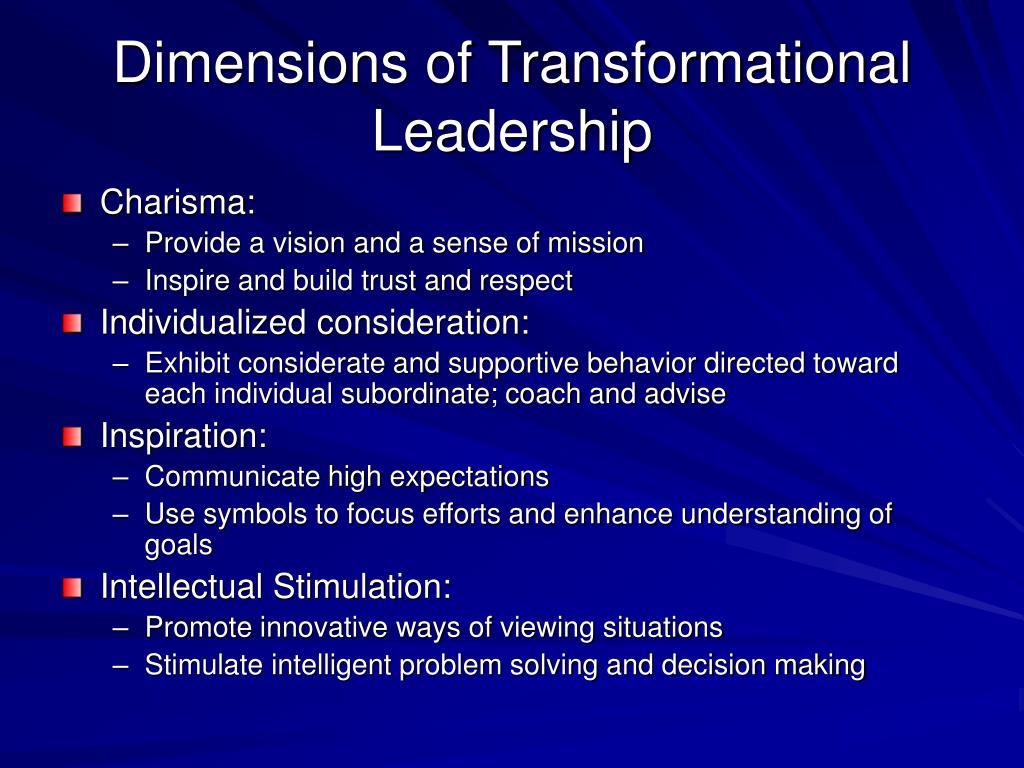Becoming an effective transformational leader is an iterative process. It is at the core of effective leadership.

PPT Transformational and Charismatic Leadership PowerPoint
These can be connected back to the 4 i’s:

Four dimensions of transformational leadership. In summary, the above review identified a set of more focused subdimensions of transformational. We proposed five more focused subdimensions of transformational leadership including vision, inspirational. The results show that the studies investigated transformational leadership practices and that the level of practices found in the sample on the four dimensions of transformational leadership—idealized influence, inspirational motivation, intellectual stimulation, and individualized consideration—ranged between two levels such as high and.
According to voon (2011), there are four dimensions of transformational leadership. These are idealized influence, inspirational motivation, intellectual stimulation and individualized consideration. Leadership including articulating a vision, inspirational communication, supportive leadership.
These are not mutually exclusive categories; Besides that, according to avolio, bass, and jung (1997) there are four dimensions of transformational leadership. Tl consists of four dimensions including:
Idealised influence concerns the formulation and articulation of vision and challenging goals and motivating. Vision is the expression of a desired picture of the future based around organizational values and should. The five dimensions of transformational leadership 1.
This means that conscious effort must be made to adopt a transformational style. 4 dimensions of transformational leadership. In effect a leader can grow their charisma by utilizing their resources effectively.
Transformational leaders help followers grow and develop into leaders by responding to individual followers' needs by empowering them and by aligning the objectives and goals of the individual followers, the leader, the group, and the larger organization. origin and development. Thus, this paper aims to discuss the model of. Transformational leadership incorporates the charismatic and affective portions of leadership and accelerates the change in the organization.
Understanding the basics of transformational leadership and the four i's can help a manager apply this approach. Tom and i considered the description of the 4 factors at the end of the page and summarized them as: While transactional leadership involves determining the tasks, rewarding goal.
The best way to do this is to be open and honest about challenges. An authentic leader serves as a role model to inspire moral and fair behavior, as well as to command esteem and confidence from colleagues. Transformational leadership style gives high regard to the importance of open communication lines within a team.
Idealized influence, inspirational motivation, individualized consideration, and intellectual stimulation. Such a scenario is considered vital in terms of providing individual feedback and recognition, as well as in ensuring that each team member knows his or her voice is valued in the organisation. According to northouse (2001), a transformational leader has the following qualities:
Transformational leadership and psychological safety climate in recent years, much attention has been shown to identifying The best organizations are blessed with both forms of leadership, and the best leaders display attributes of both and know when and how to use. The 4 leadership competencies required of most leaders are:
The four dimensions of transformational leadership of idealized influence has five attributes which are; The top goal of a transformational leader is to get the full support of everyone involved, all with an eye for the common goal. Idealized influence, inspirational motivation, intellectual stimulation, and individual consideration.
There are four factors to transformational leadership, (also known as the “four i’s”): The four aspects of transformational leadership. Dimension of transformational leadership will or will not relate to creativity, which complements van knippenberg and sitkin's (2013) argument that we should examine these dimensions separately.
Transformational leaders have the ability to inspire and motivate followers. Inspirational communication is the expression of positive and encouraging messages about. A transformational leader should have the following capabilities:
September 15, 2012 @ 11:08 am. The second element is inspirational motivation. The basis of leadership can be charted in a model that illustrates the two competing sides.
Authenticity, coaching insight and innovation. Transformational leadership is a style that motivates followers by appealing to higher ideals and moral values (katherine j.barker and suny fredonia, 2007). Combine this with idealized influence, and this is.
This study identified aspects of transformational leadership theory that have resulted in a lack of empirical support for the hypothesized factor structure of the model, and very strong relationships among the leadership components. Transformational leadership was started by james v. Dimensions of transformational leadership bass and avolio, in their book entitled “improving organizational effectiveness through transformational leadership,” suggests that transformational leadership has four dimensions which he calls “the four i’s.”1 the first dimension is called idealized influence (ideal influence).

Best Practice Transformational Leadership_BSC_PM

Diagram of Transformational Leadership — Stock Photo © vaeenma 153897748

